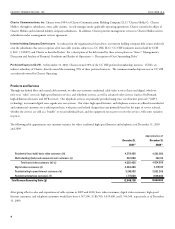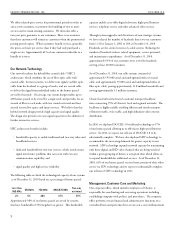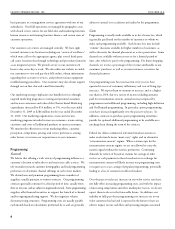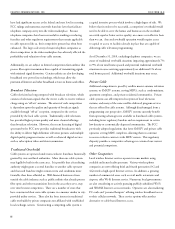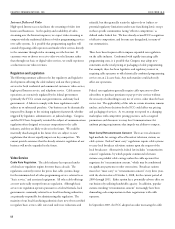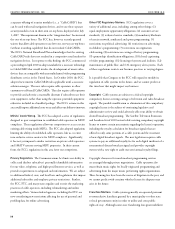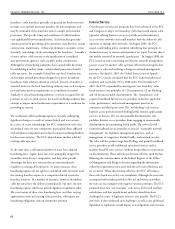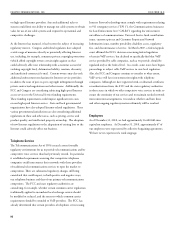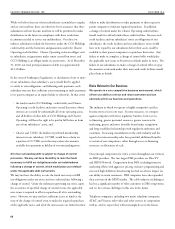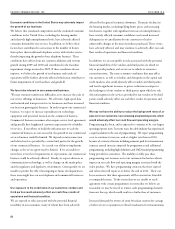Charter 2010 Annual Report Download - page 26
Download and view the complete annual report
Please find page 26 of the 2010 Charter annual report below. You can navigate through the pages in the report by either clicking on the pages listed below, or by using the keyword search tool below to find specific information within the annual report.
industry’s existing must-carry obligations by requiring most cable
operators to offer “must carry” broadcast signals in both analog
and digital format (dual carriage) for a three year period after the
broadcast television industry completed its ongoing transition from
an analog to digital format, which occurred on June 12, 2009. e
burden could increase further if cable systems were ever required
to carry multiple program streams included within a single digital
broadcast transmission (multicast carriage), which the recent
FCC order did not mandate. Additional government-mandated
broadcast carriage obligations could disrupt existing programming
commitments, interfere with our preferred use of limited channel
capacity, and limit our ability to offer services that appeal to our
customers and generate revenues. We may need to take additional
operational steps and/or make further operating and capital
investments to ensure that customers, not otherwise equipped to
receive digital programming, retain access to broadcast programming.
Access Channels. Local franchise agreements often require cable
operators to set aside certain channels for public, educational,
and governmental access programming. Federal law also requires
cable systems to designate a portion of their channel capacity for
commercial leased access by unaffiliated third parties, who generally
offer programming that our customers do not particularly desire.
e FCC adopted new rules in 2007 mandating a significant
reduction in the rates that operators can charge commercial leased
access users and imposing additional administrative requirements
that would be burdensome on the cable industry. e effect of
the FCC’s new rules was stayed by a federal court, pending a cable
industry appeal and a finding that the new rules did not comply with
the requirements of the Office of Management and Budget. Under
federal statute, commercial leased access programmers are entitled to
use up to 15% of a cable system’s capacity. Increased activity in this
area could further burden the channel capacity of our cable systems,
and potentially limit the amount of services we are able to offer and
may necessitate further investments to expand our network capacity.
Access to Programming. e Communications Act and the
FCC’s “program access” rules generally prevent satellite cable
programming vendors in which a cable operator has an attributable
interest and satellite broadcast programming vendors from favoring
cable operators over competing multichannel video distributors,
such as DBS, and limit the ability of such vendors to offer exclusive
programming arrangements to cable operators. Given the heightened
competition and media consolidation that we face, it is possible
that we will find it increasingly difficult to gain access to popular
programming at favorable terms. Such difficulty could adversely
impact our business.
Ownership Restrictions. Federal regulation of the communications
field traditionally included a host of ownership restrictions, which
limited the size of certain media entities and restricted their ability
to enter into competing enterprises. rough a series of legislative,
regulatory, and judicial actions, most of these restrictions have been
either eliminated or substantially relaxed. Changes in this regulatory
area could alter the business environment in which we operate.
Pole Attachments. e Communications Act requires most utilities
owning utility poles to provide cable systems with access to poles
and conduits and simultaneously subjects the rates charged for this
access to either federal or state regulation. e Communications
Act specifies that significantly higher rates apply if the cable plant
is providing “telecommunications” services rather than only video
services. Although the FCC previously determined that the lower
rate was applicable to the mixed use of a pole attachment for the
provision of both video and Internet access services (a determination
upheld by the U.S. Supreme Court), the FCC issued a Notice
of Proposed Rulemaking (“NPRM”) on November 20, 2007, in
which it “tentatively concludes” that such mixed use determination
would likely be set aside. In addition, a group of electric utilities
filed a petition in 2009 asking the FCC to declare that higher pole
rents apply to cable operators that provide VoIP services. In its
March 2010 National Broadband Plan, however, the FCC sought
to promote the adoption of uniform pole attachment rates by cable
operators and telecommunications providers by recommending a
reduction of the pole attachment rate paid by telecommunications
providers to, or close to, the pole attachment rate paid by cable
operators. In May 2010, the FCC issued a Further Notice of
Proposed Rulemaking seeking comment on how it could reduce
variations in pole attachment rates and facilitate access to utility
poles. While we cannot predict the outcome of these proceedings,
they could significantly increase our annual pole attachment costs
or substantially decrease the pole attachment costs paid by the
telecommunication providers with which we compete.
Cable Equipment. In 1996, Congress enacted a statute requiring
the FCC to adopt regulations designed to assure the development of
an independent retail market for “navigation devices,” such as cable
set-top boxes. As a result, the FCC required cable operators to make



